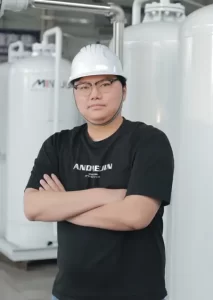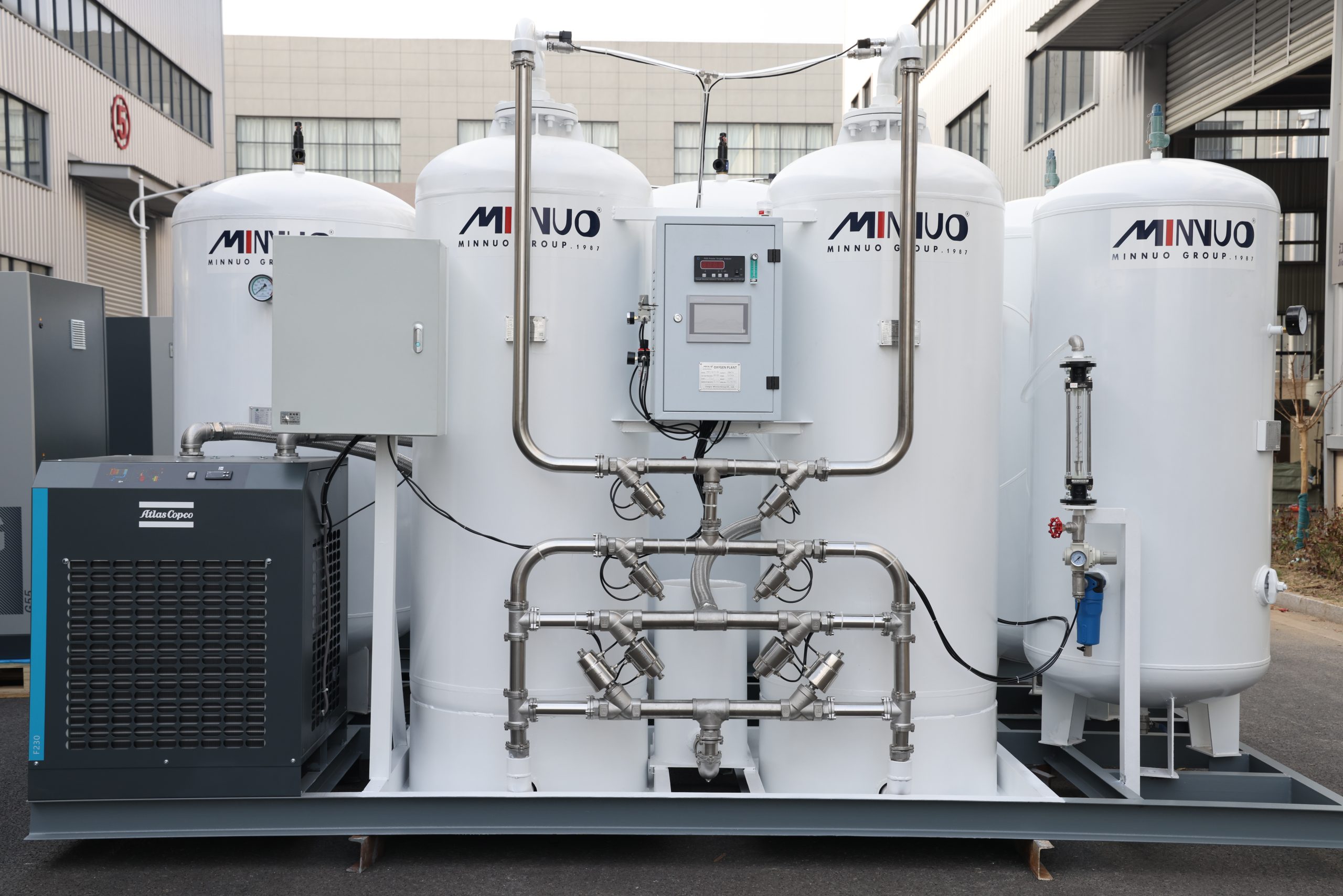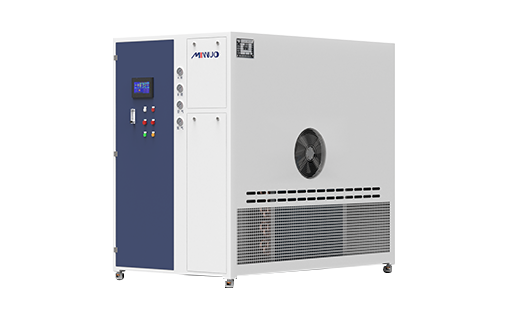PSA (Pressure Swing Adsorption) technology, as a widely used technology for gas separation, has been widely utilized in the production of oxygen and nitrogen. Through the principle of Pressure Swing Adsorption (PSA), different gases can be selectively adsorbed and desorbed by adsorption materials to realize gas separation. This paper will discuss the importance of oxygen production efficiency for PSA systems, focusing on how to improve the overall performance of PSA systems by optimizing various key indicators.
The core objective of this paper is to help readers understand how to effectively calculate and optimize key efficiency metrics in PSA oxygen production systems, especially oxygen recovery, energy efficiency, and unit energy yield. In industrial, medical, and other applications, the efficiency of oxygen production has a direct impact on the economics and sustainability of the system. Therefore, this article will provide detailed calculation methods and optimization strategies for these key indicators to help you achieve more efficient and energy-saving oxygen production.
The next section will provide an in-depth analysis of how to optimize the efficiency of a PSA system according to different operating conditions, detailing the main factors affecting the efficiency of oxygen production and demonstrating the relevant calculation methods with examples. Through this article, you will understand how to scientifically design and adjust the PSA oxygen system to achieve the best production efficiency and effectively reduce energy consumption, providing practical solutions for your industrial applications.
Ⅰ.Key Indicators of PSA System Oxygen Production Efficiency
1. Oxygen Recovery Rate
Definition:
Oxygen Recovery Rate is the ratio of the amount of oxygen extracted by the system from the input gas to the total input. It reflects the ability of the system to efficiently extract oxygen from a given gas stream.
Influencing Factors:
Inlet Gas Flow: Higher inlet gas flow means that more adsorption bed and system processing capacity is required to keep the system working efficiently, which in turn affects the recovery rate.
Operating Pressure: An increase in pressure usually increases the oxygen adsorption rate and therefore the recovery rate. However, high pressures may increase energy consumption, so there is a need to balance recovery with energy efficiency.
Adsorbent material selection: The pore size, capacity and stability of the adsorbent material directly affect the recovery rate. For example, molecular sieves should be selected for their ability to selectively adsorb oxygen.
Cycle period: The setting of adsorption and desorption cycle will affect the separation efficiency of oxygen, and a reasonable adjustment of the cycle can improve the overall energy efficiency of the system while ensuring a high recovery rate.
Calculation formula:
Recovery Rate = (Oxygen Production / Oxygen Input) × 100%
Optimization strategy:
By reasonably adjusting the operating conditions, adjusting the cycle period and optimizing the use of adsorbents, the recovery rate of the PSA system can be improved, thus increasing the efficiency of oxygen production.
2. Power and Energy Efficiency
Definition:
Energy efficiency is the amount of oxygen produced by a PSA system per unit of time at a specific power consumption. It is used to measure the efficiency of the system between energy consumption and oxygen output.
Influencing factors:
Pressure range of the system: Increase in operating pressure usually helps to increase the efficiency of oxygen production, but it also increases the energy consumption of the system, so the operating pressure range needs to be set appropriately.
Adsorbent performance and service life: the performance of the adsorbent affects the efficiency of adsorption and desorption, the selection of efficient adsorbents can not only improve the efficiency of oxygen production, but also extend the service life of the system.
Stability of oxygen production process: Stable oxygen production process can reduce energy waste and optimize oxygen production efficiency.
How to optimize the equipment: Improving the design and operating conditions of the equipment (e.g., optimizing the airflow path and improving the thermal management system of the equipment) can significantly increase the ability to produce oxygen per unit of energy.
Calculation formula:
Efficiency = (Oxygen Production (Nm³)) / (Power Consumption (kWh))
Optimization Measures:
Temperature Adjustment: Optimize the temperature control system to reduce the waste of energy due to temperature difference.
Dynamic adjustment: Reduce energy consumption and improve oxygen production rate by real-time adjustment of the system operation status.
By designing a reasonable control system and selecting high-quality adsorption materials, we can maximize the energy efficiency of the system and reduce unnecessary energy consumption. 3.
3. Unit energy yield
Definition:
Unit energy yield is the amount of oxygen produced per unit of energy consumption, reflecting the performance of PSA system energy efficiency under different operating conditions.
Influencing factors:
System design: Optimization of equipment design, adsorption bed structure and choice of adsorbent directly affect the oxygen production efficiency per unit of energy.
Equipment Maintenance: Regular equipment maintenance and adsorbent replacement helps to maintain efficient system operation and minimize energy waste.
Operating conditions: Conditions such as temperature, pressure and gas flow affect gas distribution and adsorption efficiency, and thus oxygen production per unit of energy.
Calculation formula:
Unit Energy Production Rate = (Oxygen Production (Nm³)) / (Energy Consumption (kWh))
Optimization Suggestions:
Reduce energy loss: Through reasonable selection of adsorbent, optimization of cycle time and adjustment of pressure and other measures, the energy loss of the system can be reduced.
Dynamic adjustment: Adopt intelligent control system to adjust the operation status of the system in real time, so as to reduce the energy consumption during the low demand period.
II. Methods for Calculating PSA System Efficiency and Practical Applications
1. Efficiency calculation models
Efficiency models are the basis for evaluating the performance of PSA (Pressure Swing Adsorption) systems. They usually include the following types of models:
Mass balance method: Based on the relationship between gas input and output in the system, the extraction rate and loss of oxygen or nitrogen are calculated by the law of conservation of mass.
Thermodynamic model: Used to analyze the energy conversion and loss in the system, assess the unit energy consumption and thermal efficiency, commonly used in energy optimization design.
Kinetic model: focus on the adsorption and desorption process rate changes, used to adjust the cycle time and adsorbent selection.
Typical efficiency indicators and calculation examples:
Oxygen recovery rate calculation:
Recovery Rate = (Oxygen Production / Oxygen Input) × 100%
Energy Efficiency:
Efficiency = (Oxygen Production (Nm³)) / (Power Consumption (kWh))
Rate of output per unit of energy:
Unit Energy Production Rate = (Oxygen Production (Nm³)) / (Energy Consumption (kWh))
Example of practical application:
Take an industrial 93% purity medical oxygen generator as an example, calculate the efficiency indexes according to the parameters of inlet flow (30 Nm³/h), pressure (5bar), adsorbent filling volume (120kg), and evaluate its energy consumption and stability performance during the low peak operation at night.
2. Efficiency optimization in actual application
In actual operation, it is difficult to achieve the best efficiency only through theoretical design, so it is necessary to make real-time adjustment and optimization according to the actual working conditions. The following are some key measures:
Optimize air inlet conditions:
Air flow regulation: Keep the flow rate in a reasonable range to avoid incomplete adsorption or high flux leading to separation failure.
Temperature management: Control the ambient temperature or set up a cooling system to prevent high temperatures from causing adsorbent failure.
Pressure fluctuation control: Use pressure stabilizing valves and variable frequency compressors to suppress the negative impact of pressure fluctuations on separation efficiency.
Adsorbent management:
Select adsorbent materials with appropriate particle size and specific surface area to improve adsorption capacity and desorption rate.
Regularly replace or regenerate the adsorbent to avoid efficiency reduction due to adsorption saturation or contamination.
Cycle control optimization:
Adjust the adsorption/desorption/equilibration cycle ratio (e.g. 2:2:1) to match the system load.
Adopt PLC or DCS control system to realize automated regulation and feedback closed loop to improve operation efficiency and stability.
Suggestions for system modification and upgrading:
Replace old components such as check valves and gas storage tanks to reduce pressure drop and system energy consumption.
Add online monitoring devices such as flow meters and oxygen analyzers to improve management efficiency.
III. Factors affecting PSA oxygen production efficiency
1. Operating conditions
Influence of temperature, pressure, flow rate and cycle time
PSA (Pressure Swing Adsorption) oxygen production efficiency is directly affected by operating conditions. Different operating conditions, such as temperature, pressure, gas flow rate and adsorption cycle, affect the adsorption and desorption effects during oxygen production.
Effect of temperature:
Temperature variations affect the selectivity of the adsorbent and the rate of adsorption. Typically, high temperatures cause a decrease in the adsorption capacity of the adsorbent, resulting in lower oxygen recovery, so systems operating at high temperatures must be effectively cooled to maintain efficiency. Conversely, low temperatures can affect the activity of the molecular sieve and reduce the capacity of the system.
Effect of pressure:
High pressure helps to improve the adsorption efficiency of molecular sieves, and usually, the separation effect of oxygen is directly related to pressure. Increasing the pressure can improve the output rate and purity of oxygen, but at the same time, it will also increase the energy consumption, so we need to reasonably control the pressure to balance the production efficiency and energy consumption.
Influence of flow rate:
The flow rate determines the residence time of the gas in the molecular sieve bed. Too fast flow rate may lead to insufficient separation of oxygen, thus affecting the purity and recovery rate; while too slow flow rate may lead to inefficient operation of the system, resulting in unnecessary waste of energy.
Effect of Cycle Time:
Adjustment of the adsorption and desorption cycles is critical to system efficiency. Too short a cycle can affect oxygen purity, while too long a cycle may reduce the system’s productivity. Therefore, optimizing cycle times to ensure efficient separation and high throughput is key to improving productivity.
Optimization measures:
Ensuring that the PSA system is operated at optimal operating conditions through real-time regulation of temperature, pressure and flow rate can significantly improve oxygen production efficiency and reduce energy consumption. The use of intelligent control systems and automated regulation can dynamically optimize these operating conditions to ensure stable system operation.
2. Selection of adsorbent
Influence of adsorbent type and quality on efficiency
Adsorbent plays a vital role in PSA system, which determines the effectiveness of the gas separation process. Different types of adsorbents (e.g. molecular sieve, activated carbon, etc.) have different adsorption properties for gases, and the selection of suitable adsorbents has a direct impact on the improvement of oxygen recovery and separation efficiency.
Types of adsorbents:
Molecular sieve is usually used for oxygen separation because it has better selectivity and can effectively separate oxygen from nitrogen, while activated carbon is more suitable for removing organic pollutants. Choosing the right adsorbent can improve the purity of oxygen and reduce energy consumption.
Performance of adsorbents:
The pore size, specific surface area, pressure drop and adsorption capacity of adsorbents directly affect the treatment capacity of the system. To optimize efficiency, adsorbent materials with high adsorption capacity, long service life and high temperature resistance should be selected.
Maintenance and Replacement of Adsorbents:
Adsorbents become saturated or contaminated with time of use, thus reducing their efficiency. Regular cleaning or replacement of the adsorbent can effectively maintain the efficient operation of the system.
Optimization Measures:
By choosing and optimizing the adsorbent appropriately, the overall efficiency of the PSA system can be significantly improved, the service life of the equipment can be prolonged, and the operating cost can be reduced. It is recommended that the appropriate adsorbent be selected at the design stage to ensure that the system can maintain efficient operation under different loads.

3. Equipment Configuration and Maintenance
The Importance of Equipment Design and Regular Maintenance
The configuration and maintenance status of the equipment directly determines the productivity and stability of the PSA system. Well-designed equipment can not only improve the oxygen production and recovery rate, but also reduce the system failure rate and prolong the service life.
Equipment design:
The design of the equipment should take into account factors such as gas flow, adsorbent configuration, piping layout and pressure control. Reasonable design of adsorption tower, gas inlet and outlet and pipeline structure can effectively reduce the uneven flow and pressure drop problems, optimize the gas flow path and improve production efficiency.
Equipment Maintenance:
Regular inspection and maintenance of equipment, including replacement of deteriorated parts, cleaning of adsorption towers and piping, and inspection of valves and pressure sensors, will help to keep the system running stably for a long time. Malfunctioning or improper maintenance of equipment may result in poor gas flow, reduced system efficiency, or even serious malfunctions.
Optimization measures:
Regular maintenance and timely repair of equipment problems to ensure that the equipment is running in optimal condition can extend system life and reduce downtime. An automated monitoring system can track equipment conditions in real time, detecting and dealing with potential problems in advance.
IV. Strategies to Improve PSA Oxygen Production Efficiency
1. Optimize system design
Design reasonable system configuration to improve efficiency
Optimizing the design of PSA oxygen system is the first step to improve efficiency. Proper design of key equipment such as compressors, adsorption towers, heat exchangers, etc. can significantly improve the operating efficiency and oxygen production capacity of the system. The following are a few important optimization design strategies:
Pressure Optimization: Balancing the pressure difference between the stages through rational design of the pressure cycle can help optimize the adsorption and desorption process, thus improving oxygen production and purity.
Adsorption tower optimization: The layout and internal structure of the adsorption tower have a significant impact on the efficiency of the system. Optimizing the bed design ensures uniform distribution of airflow and reduces airflow dead zones, thus improving adsorption efficiency.
Heat exchanger design: The optimization of heat exchanger can effectively recover waste heat, reduce energy consumption, and ensure continuous and efficient operation of the system. Through the heat recovery system, the cooling load can be reduced to further improve energy efficiency.
Dynamic System Regulation and Flexible Expansion:
The system design should take into account the flexible regulation under different working loads to ensure that the system can reduce energy consumption at low loads and meet higher gas production demands at high loads. In this way, the design is not only adaptable to existing demand, but also able to cope with future growth.
2. Adoption of advanced control systems
Automated control and real-time monitoring technologies
The introduction of automated control systems and real-time monitoring technologies is key to improving the efficiency of the PSA oxygen system. Intelligent control systems can automatically adjust pressure, flow rate and other parameters based on real-time data during operation to ensure that the system is in the best operating condition.
Pressure and flow rate optimization: Adopting precise pressure control technology, the pressure at different stages can be automatically adjusted to ensure the best gas separation effect. The flow control system optimizes the flow rate of the gas through each adsorption bed through dynamic adjustment to further improve the separation efficiency.
Real-time monitoring system: Using sensors and data acquisition systems, the system’s operating status (such as oxygen concentration, temperature, pressure, etc.) is monitored in real time, and the system operation is optimized through intelligent algorithms to reduce unnecessary energy waste.
Enhanced system stability:
By implementing advanced monitoring and regulation systems, manual intervention can be reduced, system failure rates can be minimized, and production stability can be improved. This application of technology not only improves the operational efficiency of the system, but also extends the service life of the equipment.
3. Application of energy-saving technologies
Frequency conversion technology and energy-saving equipment
Frequency conversion technology and recycling technology have great potential to enhance the efficiency of PSA systems. By optimizing operation and reducing unnecessary energy consumption, operating costs can be effectively reduced.
Variable Frequency Drive: The use of variable frequency drives allows the system to adjust its operating speed in response to changes in load, reducing energy consumption at low loads and increasing efficiency at high loads, reducing excessive energy consumption.
Exhaust Gas Recovery: In PSA systems, exhaust gas recovery technology can reuse incompletely separated gases and reduce gas waste. Through the optimized design of the recovery system, inefficient gases are returned to the adsorption tower for secondary treatment, which improves resource utilization and reduces operating costs.
Heat Recovery Technology:
Heat recovery technology significantly improves the energy efficiency of a system by recovering and utilizing waste heat from system operation. For example, recovering waste heat from a system using a highly efficient heat exchanger can be used to preheat the gases entering the system, reducing energy demand and improving overall efficiency.
Conclusion
This paper comprehensively discusses the key indicators of PSA oxygen production efficiency and their calculation methods, focusing on the impact of oxygen recovery rate, energy efficiency, and unit energy yield on system operation. By optimizing the operating conditions, adsorbent selection and system design, improving the efficiency of the PSA oxygen system can not only increase the oxygen production, but also significantly reduce the energy consumption, thus achieving higher operational efficiency.
With the continuous development of PSA technology, intelligent control system and advanced energy-saving technology will become the trend of the industry in the future.MINNUO is committed to innovation and service in the field of PSA oxygen system, providing efficient and energy-saving PSA solutions to meet the needs of different industries. By optimizing system design and energy-saving technologies, MINNUO provides customers with stable and reliable oxygen production systems, helping them to improve production efficiency and reduce operating costs, and promoting the sustainable development of the industry.






 sales2:+86 17506119168
sales2:+86 17506119168

